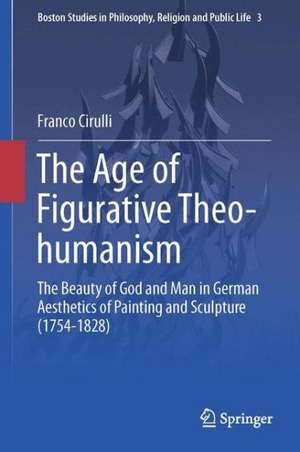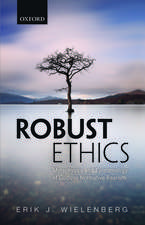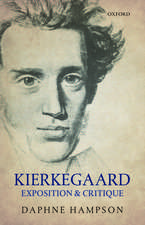The Age of Figurative Theo-humanism: The Beauty of God and Man in German Aesthetics of Painting and Sculpture (1754-1828): Boston Studies in Philosophy, Religion and Public Life, cartea 3
Autor Franco Cirullien Limba Engleză Hardback – 22 mai 2015
| Toate formatele și edițiile | Preț | Express |
|---|---|---|
| Paperback (1) | 383.33 lei 6-8 săpt. | |
| Springer International Publishing – 9 oct 2016 | 383.33 lei 6-8 săpt. | |
| Hardback (1) | 390.63 lei 6-8 săpt. | |
| Springer International Publishing – 22 mai 2015 | 390.63 lei 6-8 săpt. |
Preț: 390.63 lei
Nou
Puncte Express: 586
Preț estimativ în valută:
74.76€ • 77.84$ • 63.18£
74.76€ • 77.84$ • 63.18£
Carte tipărită la comandă
Livrare economică 10-24 martie
Preluare comenzi: 021 569.72.76
Specificații
ISBN-13: 9783319099996
ISBN-10: 331909999X
Pagini: 180
Ilustrații: XVIII, 191 p. 17 illus., 14 illus. in color.
Dimensiuni: 155 x 235 x 20 mm
Greutate: 0.48 kg
Ediția:2015
Editura: Springer International Publishing
Colecția Springer
Seria Boston Studies in Philosophy, Religion and Public Life
Locul publicării:Cham, Switzerland
ISBN-10: 331909999X
Pagini: 180
Ilustrații: XVIII, 191 p. 17 illus., 14 illus. in color.
Dimensiuni: 155 x 235 x 20 mm
Greutate: 0.48 kg
Ediția:2015
Editura: Springer International Publishing
Colecția Springer
Seria Boston Studies in Philosophy, Religion and Public Life
Locul publicării:Cham, Switzerland
Public țintă
ResearchCuprins
Preface.- Introduction.- I. Winckelmann: The Responsibility of Aesthetic Response.- II. Hemsterhuis and Herder: Sculptural Theo-humanism.- III. Moritz, Wackenroder, Schelling: Tragic Theo-aesthetics.- IV. The Jena Circle and Hegel: The Modernity of Painting.- V. Conclusion.
Notă biografică
Franco Cirulli is a scholar in Aesthetics and in 18th and 19th century philosophy. He is the author of published essays on German Idealism, and on the theology of painting. In 2006, Routledge has published his Hegel’s Critique of Essence – A Reading of the Wesenslogik, a monograph devoted to Hegel’s metaphysics of natural necessity vs. freedom. He is a Lecturer in the Core Curriculum at Boston University.
Textul de pe ultima copertă
This is a comprehensive, integrated account of eighteenth and early nineteenth century German figurative aesthetics. The author focuses on the theologically-minded discourse on the visual arts that unfolded in Germany, circa 1754-1828, to critique the assumption that German romanticism and idealism pursued a formalist worship of beauty and of unbridled artistic autonomy. This book foregrounds what the author terms an “Aesthetics of Figurative Theo humanism”. It begins with the sculptural aesthetics of Johann Joachim Winckelmann and Gottfried Herder before moving on to Karl Philipp Moritz, Wilhelm Heinrich Wackenroder and Friedrich Schelling. The reader will discover how this aesthetic tradition, after an initial obsession with classical sculpture, chose painting as the medium more suited to the modern self’s exploration of transcendence. This paradigm-shift is traced in the aesthetic discourse of Friedrich Schlegel and Georg Wilhelm Friedrich Hegel. In this work, the widespread prejudice that such aesthetics initiated a so-called “Modern Grand Narrative of the Arts” is deconstructed. One accusation directed at 18th century aesthetics has been that it realised into “Art” what had previously been a living, rich tissue of meaning: this work shows how Figurative Theo humanism's attention to aesthetic values was never detached from deeper theological and humanistic considerations. Furthermore, it argues that this aesthetic discourse never forgot that it emerged from modern disenchantment—far from occluding the dimension of secularization, it draws poignant meaning from it. Anyone with an interest in the current debates about the scope and nature of aesthetics (philosophers of art, theology, or religion) will find this book of great interest and assistance.
Caracteristici
Explores the theological and humanist concerns that animate German philosophical discourse on sculpture and painting, circa 1754-1828 Critiques the widespread assumption that German Romanticism and Idealism reduced the originally religious nature of figurative art to a formalist worship of beauty and of unbridled artistic autonomy Provides an historical framework for contemporary debates about the nature and future of aesthetics Includes supplementary material: sn.pub/extras
























